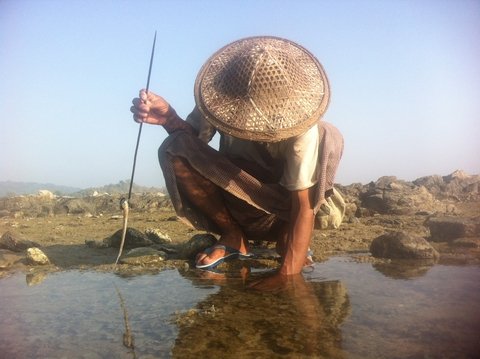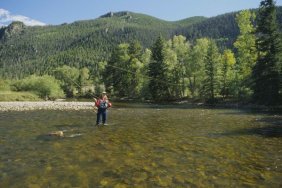The basic order of survival is pretty standard. Shelter, water, fire and food (almost always in that order). Considering that most people get lost in the woods, your water source just might be your best food source if you know a few basics about fishing.
Very few people that become lost in the wilderness are carrying fishing gear (I’m talking about a rod, reel and bait), but that doesn’t mean you can’t catch fish if you need food and find yourself in a pickle. People have been catching fish for eons without modern gear and some still are.
If you are pretty savvy, you could make a Huckleberry Finn setup but most folks would probably end up wasting a lot of time and energy only to get skunked (fish are smart). I’ve had students attempt to make primitive fishing poles and hooks and most gave up. There are better methods.
Believe it or not, even today, only half of the fish caught by Aboriginal people are caught using lines. The other methods are hand collection, nets and spears (in that order). One of the easiest ways to catch fish is by making a fish wall.
Hand Collection
Start by making a dam downstream (around a bend if possible) with a small opening for the fish to go in. The idea is to go upstream and scare the fish down to the dam. We’ve done this by taking a branch with leaves on it and walking downstream waving it. You will almost always get a fish or two in the dam. The hard part is catching them by hand.
Nets
Another great method is to make a net. Willow is found along most creeks and streams. Willow is pretty flexible and strong. Cut a long piece for the handle and bend the end into a loop. Tie it off and you have something that resembles a net (without the net part). For the net, you can use paracord or whatever line you have. You can also use fabric (here’s where you need to get creative).
Now if for some reason you don’t have any rope or extra fabric (not too likely), you can peel bark off other willow branches (it’s pretty easy to get long strips). Tie and weave the strips to make the net. It doesn’t need to be pretty, just tight enough so that fish don’t get out. Look around for flexible cordage. Cattail works really well too.
So you’re probably thinking; “well, I could have made a hook and line just as fast.” Here’s the good news. Remember the fish wall you made? You can use the net to catch those fish. You can also net fish under banks, near boulders and wherever else you want. With a little bit of luck and persistence, you’ll probably get dinner.
Spear
Another alternative method that has stood the test of time is a fish spear. Most fish spears consist of a long pole (the straighter the better) with a forked end. To make the fork, carefully split the end of the pole four ways. Wrap just below the splits to avoid further splitting. Wedge a couple of sticks where you make your splits to spread the forks and then sharpen them. You can even cut barbs. Fish spears work better if you’ve had some practice and can be frustrating to use. I would try the above methods first.
The bottom line is that in a survival situation, common sense, determination and persistence are the things that keep people alive. There is never a “cut and dry” scenario, it’s always different. I’ve seen very few streams and creeks that don’t have fish in them and fish are excellent protein. Somehow you need to find that protein or you’ll certainly perish. Unless you know you where to go, stay where the water is and keep trying until you’re found.
Photo credit: Dreamstime








